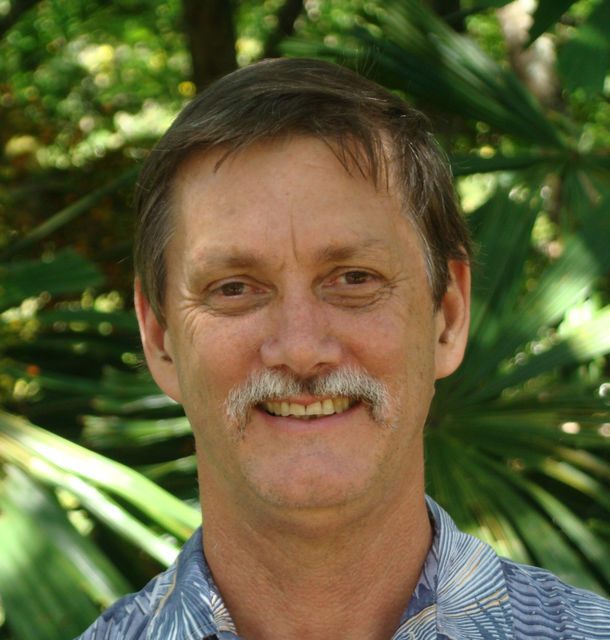LIHUE — Chipper Wichman, head of the National Tropical Botanical Garden, said receiving The Nature Conservancy’s Kako’o ‘Aina Award was one of the more humbling experiences of his life. “I’ve received a few awards over the years, but to receive
LIHUE — Chipper Wichman, head of the National Tropical Botanical Garden, said receiving The Nature Conservancy’s Kako’o ‘Aina Award was one of the more humbling experiences of his life.
“I’ve received a few awards over the years, but to receive this award from The Nature Conservancy was so meaningful,” Wichman said.
The award, established in 2006, honors individuals who have provided significant and long-standing support for conservation in Hawaii, according to The Nature Conservancy.
“Chipper Wichman has worked tirelessly for the past 40 years to plant the seeds of conservation in the Islands,” said Ulalia Woodside, executive director of The Nature Conservancy. “His passion for conservation has forged a life, a profession, and a mission to preserve nature and the culture in Hawaii.”
The award itself is a kako’o, or staff carved from two types of rare wood and it was delivered in procession with a chant created by San ‘Ohu Gon, the Conservancy’s senior scientist and cultural advisor.
“There’s a lot of meaning in the staff, the two woods that it’s carved from are amazing and rare,” Wichman said. “And Sam created a chant that was associated with our leadership that gave me chicken skin.”
Whichman started at NTBG in 1976 as an intern and took Limahuli Valley on Kauai’s North Shore under his wing after the death of his grandmother, Juliet Rice Wichman, who urged him to protect the land.
For the next seven years, Wichman and his wife Hau’oli restored the ancient taro terraces and developed a collection of rare and endangered native Hawaiian plants. Now, those plants make up Limahuli Garden and Preserve, which they gifted to NTBG in 1994.
Wichman’s work also extends to Maui, where he guided the creation of Kahanu Garden in Hana and to other Hawaiian Islands, but he’s not limited to the archipelago.
The award also acknowledges Wichman for his substantial role in bringing the 2016 International Union for Conservation of Nature’s World Conservation Congress to Oahu in September.
“It was really a lifetime achievement award and they alluded to my leadership in the world conservation congress, but they cited the cultural work that we’ve done, (too),” Wichman said.
Honoring the restoration work with cultural systems in Hawaii was “very rewarding” for Wichman.
Now that the world conservation congress is over, Wichman said he’s turning his attention to two projects that are affecting Hawaii: rapid ohia death and increasing sustainable food production on Kauai.
About 80 percent of Kauai’s watershed is composed of ohia, and Wichman said the species is a “keystone species” for the Garden Isle.
“I would define the consequences (of ohia death on Kauai) as unimaginable and I feel like I should be turning a good part of my attention to solve this problem,” Wichman said. “There are many aspects of Native Hawaiian biodiversity that are in symbiotic relationships with ohia.”
Currently, Hawaii is in a triage situation when it comes to rapid ohia death, and Wichman said he’ll be focusing on the pathogen and further defining how it’s spread.
Creating food security for Hawaii, which only has about five days worth of fresh produce on hand statewide, is also a priority for Wichman.
“Food security is a huge issue in the state of Hawaii and the governor has pledged to double the amount of local food production in Hawaii,” Wichman said. “But, we’re not sure how to do that.”
For answers, he and the NTBG have turned to breadfruit.
“All of these other crops are harvest crops that are labor intensive, and you get topsoil loss every time,” Wichman said. “Plant one breadfruit tree and it’ll feed a community for 30 years.”
Breadfruit also ties into Wichman’s vision of creating the world’s first regenerative agriculture parks on Kauai, or areas dedicated to pilot projects for regenerative agriculture.
“We believe breadfruit can lead the world in developing regenerative agriculture solutions toward feeding communities and at the same time, producing valuable commodities,” Wichman said. “I’d like to see Hawaii be the first place in the world to designate regenerative ag parks.”
So, though his time has been freed with the conclusion of the IUCN world conservation congress, Wichman said he’ll be attending general plan update meetings to try and lay out plans for a regenerative ag park and to help create economic viability and food security for the state.



